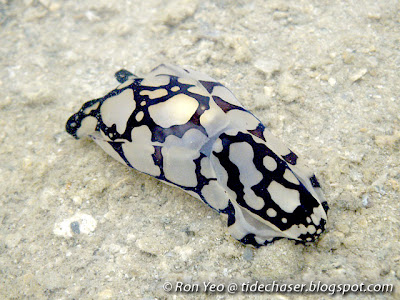Headshield slugs (clade Cephalaspidea) are marine slugs with a well-developed headshield, which is a broadening at the head. This headshield prevents sand from entering the slug's mantle cavity as it burrows. Most headshield slugs have a greatly reduced and thin shell or an internal shell, though some species may lack a shell altogether.
Many headshield slugs are often also called bubble snails, as their thin shell and round shells appear like bubbles. Many are predatory and feed on other small animals, such as snails and polychaetes, while the others feed on algae.
In Singapore, several species of headshield slugs can be found, but personally I have only seen 3 species.

The Pilsbry's Headshield Slug (Philinopsis pilsbryi) is occasionally seen on sandy substrates of our shores. Slugs from the Philinopsis genus generally feed on other headshield slugs.

The Swallowtail Headshield Slug (Chelidonura pallida) got its common name from the characteristic long split in the tail, of which the left side is always longer than the right. These slugs have well-developed eyes on the front end of the head and bundles of sensory structures around the mouth, which they use to track tiny acoel worms to feed on by following their mucous trails.

The Philine Headshield Slug (Philine sp.) appears like a white, wedge-shaped blob. Like other headshield slugs, it can burrow into the sand. It secretes a layer of mucous which aids in the burrowing. Philine spp. are generally believed to feed on bivalves, which they crush with three calcareous gizzard plates.

The Glassy Bubble Shells (Haminoea tenera) are usually found on muddy or sandy substrates, often near mangroves. At least two Haminoea species are found in Singapore, and they can be quite tough to tell apart in the field. These slugs are social animals, and will leave behind a mucus trail for other individuals to follow. They are known to eject chemicals to the surrounding when disturbed to warn other slugs. They feed on algae and tiny organic particles (detritus) on the sand.
Previously, it was thought that the Paper Bubble Snails (Family Aplustridae, previously known as Hydatinidae) were also headshield slug, but recent molecular phylogeny studies have shown that they are in fact of a separate group.

The above is a Zoned Paper Bubble Snail (Hydatina zonata). Do note that this is NO longer classified as a Headshield Slug. The soft parts of this snail cannot retract completely into the shell, and hence it avoids predation by swimming. Other paper bubble snails may avoid predation by camouflage. They feed on cirratulinid polychaete worms.
References

The Pilsbry's Headshield Slug (Philinopsis pilsbryi) is occasionally seen on sandy substrates of our shores. Slugs from the Philinopsis genus generally feed on other headshield slugs.

The Swallowtail Headshield Slug (Chelidonura pallida) got its common name from the characteristic long split in the tail, of which the left side is always longer than the right. These slugs have well-developed eyes on the front end of the head and bundles of sensory structures around the mouth, which they use to track tiny acoel worms to feed on by following their mucous trails.

The Philine Headshield Slug (Philine sp.) appears like a white, wedge-shaped blob. Like other headshield slugs, it can burrow into the sand. It secretes a layer of mucous which aids in the burrowing. Philine spp. are generally believed to feed on bivalves, which they crush with three calcareous gizzard plates.

The Glassy Bubble Shells (Haminoea tenera) are usually found on muddy or sandy substrates, often near mangroves. At least two Haminoea species are found in Singapore, and they can be quite tough to tell apart in the field. These slugs are social animals, and will leave behind a mucus trail for other individuals to follow. They are known to eject chemicals to the surrounding when disturbed to warn other slugs. They feed on algae and tiny organic particles (detritus) on the sand.
Previously, it was thought that the Paper Bubble Snails (Family Aplustridae, previously known as Hydatinidae) were also headshield slug, but recent molecular phylogeny studies have shown that they are in fact of a separate group.

The above is a Zoned Paper Bubble Snail (Hydatina zonata). Do note that this is NO longer classified as a Headshield Slug. The soft parts of this snail cannot retract completely into the shell, and hence it avoids predation by swimming. Other paper bubble snails may avoid predation by camouflage. They feed on cirratulinid polychaete worms.
References
- Gosliner, T. M., D. W. Behrens & Á. Valdés 2008. Indo-Pacific nudibranchs and sea slugs: a field guide to the World’s most diverse fauna. Sea Challengers/California Academy of Sciences: Gig Harbor/San Francisco, 426 pp.
- Rudman, W. B. 2012. Sea Slug Forum. Retrieved May 10, 2012, from http://www.seaslugforum.net.
- Tan, S. K. & H. P. M. Woo, 2010. A preliminary checklist of the molluscs of Singapore. Raffles Museum of Biodiversity Research, National University of Singapore, Singapore. 78 pp. Uploaded 02 June 2010.
- Tan, S. K. & R. K. H. Yeo, 2010. The intertidal molluscs of Pulau Semakau: preliminary results of “Project Semakau”. Nature in Singapore, 3: 287–296.

No comments:
Post a Comment